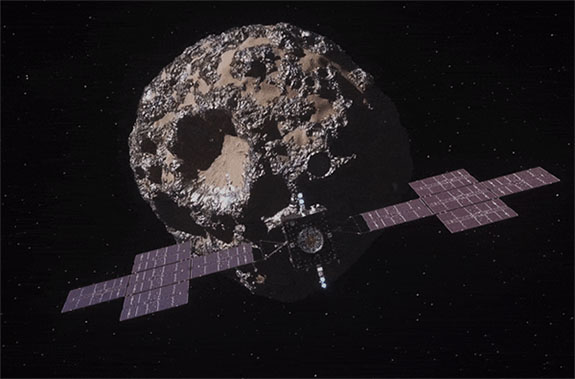NASA Launches 2.2-Billion-Mile Mission to Metal-Rich '16 Psyche' Asteroid
NASA’s six-year, 2.2-billion-mile mission to metal-rich “16 Psyche” lifted off from Florida's Kennedy Space Center just after 10 a.m. ET Friday aboard a SpaceX Falcon Heavy rocket. 16 Psyche is a 140-mile-wide asteroid that looks like a potato, but could be made of gold, platinum, iron and nickel — putting its potential precious metal value at $700 quintillion (700 followed by 18 zeros).

“This will be our first time visiting a world that has a metal surface," Lindy Elkins-Tanton, Psyche principal investigator and foundation and regents professor at Arizona State University’s School of Earth and Space Exploration, told CNN. "There aren’t that many completely unexplored types of worlds in our solar system for us to go see, so that is what is so exciting about this.”
The Psyche spacecraft is scheduled to fly by Mars in May 2026 and use the planet’s gravity to slingshot its trajectory toward Psyche. The mission is expected to meet up with the asteroid in late July 2029 and spend the next 26 months mapping its surface, taking images and determining whether scientist's predictions about Psyche's metal core are truly accurate.
Beyond the precious metal implications for the nascent space-mining industry, NASA and its university partners are excited to explore 16 Psyche because it appears to be the exposed core of an early planet, perhaps the size of Mars, that lost its rocky outer layers due to violent collisions that occurred while the solar system was forming.
Measuring about 140 miles in diameter (1/16th the diameter of Earth’s Moon), 16 Psyche could present scientists with a close representation of what lies deep within planets, such as Earth, Mercury, Venus and Mars.
According to NASA, the asteroid is the only known place in our solar system where scientists might be able to examine an exposed metal core. Unlike many objects in the solar system that rotate like a spinning top, the asteroid Psyche rotates on its side, like a wheel. NASA scientists had to take this unique characteristic into account when planning the spacecraft's orbits.
Psyche 16 is named after the nymph Psyche, who, according to Roman mythology, married Cupid but was put to death by Venus. At Cupid’s request, Jupiter — the king of the Gods — made Psyche immortal. The unique metal asteroid was discovered in 1852 by Italian astronomer Annibale de Gasparis.
The US government has already made legal preparations for the eventuality of space mining. The SPACE Act, which became law in 2015, includes provisions for private companies to extract resources from asteroids with limited government interference. Although the law does not allow for companies to claim, say, an asteroid, for their own, miners may keep anything they obtain from their exploration and mining.
Credit: NASA/JPL-Caltech/ASU.

“This will be our first time visiting a world that has a metal surface," Lindy Elkins-Tanton, Psyche principal investigator and foundation and regents professor at Arizona State University’s School of Earth and Space Exploration, told CNN. "There aren’t that many completely unexplored types of worlds in our solar system for us to go see, so that is what is so exciting about this.”
The Psyche spacecraft is scheduled to fly by Mars in May 2026 and use the planet’s gravity to slingshot its trajectory toward Psyche. The mission is expected to meet up with the asteroid in late July 2029 and spend the next 26 months mapping its surface, taking images and determining whether scientist's predictions about Psyche's metal core are truly accurate.
Beyond the precious metal implications for the nascent space-mining industry, NASA and its university partners are excited to explore 16 Psyche because it appears to be the exposed core of an early planet, perhaps the size of Mars, that lost its rocky outer layers due to violent collisions that occurred while the solar system was forming.
Measuring about 140 miles in diameter (1/16th the diameter of Earth’s Moon), 16 Psyche could present scientists with a close representation of what lies deep within planets, such as Earth, Mercury, Venus and Mars.
According to NASA, the asteroid is the only known place in our solar system where scientists might be able to examine an exposed metal core. Unlike many objects in the solar system that rotate like a spinning top, the asteroid Psyche rotates on its side, like a wheel. NASA scientists had to take this unique characteristic into account when planning the spacecraft's orbits.
Psyche 16 is named after the nymph Psyche, who, according to Roman mythology, married Cupid but was put to death by Venus. At Cupid’s request, Jupiter — the king of the Gods — made Psyche immortal. The unique metal asteroid was discovered in 1852 by Italian astronomer Annibale de Gasparis.
The US government has already made legal preparations for the eventuality of space mining. The SPACE Act, which became law in 2015, includes provisions for private companies to extract resources from asteroids with limited government interference. Although the law does not allow for companies to claim, say, an asteroid, for their own, miners may keep anything they obtain from their exploration and mining.
Credit: NASA/JPL-Caltech/ASU.

